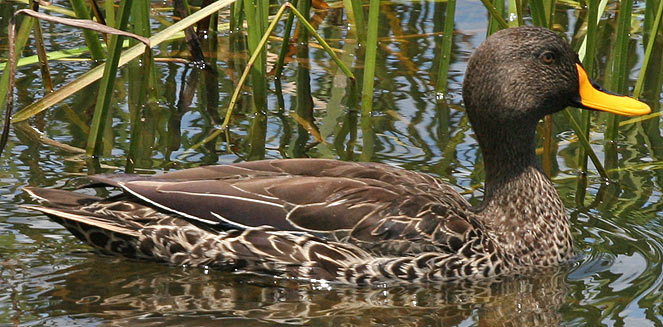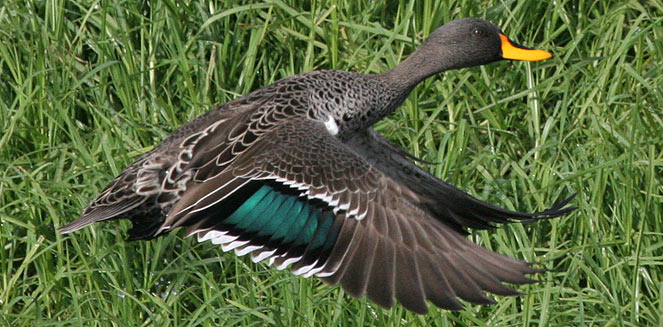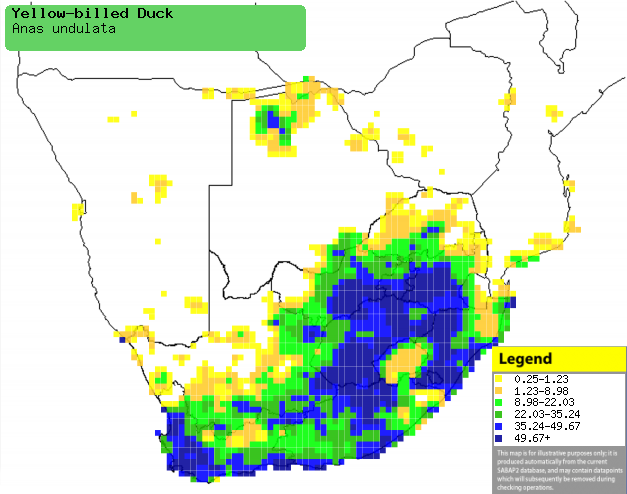|
Anas undulata (Yellowbilled
duck)
Geelbekeend [Afrikaans]; Idada (generic
term for duck) [Xhosa]; iDada (generic term for duck) [Zulu]; Siwoyo (generic
term for duck) [Kwangali]; Letata (generic term for duck) [South Sotho]; Dada,
Sekwe (both are generic names for duck or goose) [Shona]; Sekwa (generic term
for duck or goose) [Tsonga]; Sehudi (generic term for duck) [Tswana];
Geelbekeend [Dutch]; Canard à bec jaune [French]; Gelbschnabelente [German];
Pato-de-bico-amarelo [Portuguese]
Life
> Eukaryotes >
Opisthokonta
> Metazoa (animals) >
Bilateria >
Deuterostomia > Chordata >
Craniata > Vertebrata (vertebrates) > Gnathostomata (jawed
vertebrates) > Teleostomi (teleost fish) > Osteichthyes (bony fish) > Class:
Sarcopterygii (lobe-finned
fish) > Stegocephalia (terrestrial
vertebrates) > Tetrapoda
(four-legged vertebrates) > Reptiliomorpha > Amniota >
Reptilia (reptiles) >
Romeriida > Diapsida > Archosauromorpha > Archosauria >
Dinosauria
(dinosaurs) > Saurischia > Theropoda (bipedal predatory dinosaurs) >
Coelurosauria > Maniraptora > Aves
(birds) > Order: Anseriformes
> Family: Anatidae
 |
|
Yellow-billed duck, Heldeberg Nature Reserve,
Western Cape, South Africa. [photo Duncan Robertson ©]. |
 |
|
Yellow-billed duck, Strandfontein Sewerage Works,
Western Cape, South Africa. [photo Duncan Robertson ©]. |
The Yellow-billed duck is found mainly in South Africa, where
it is very common. It lives in most types of wetlands, as long as they are
still-bodied and not saline. The adults feed mainly feed on plants, while the
juveniles eat mainly invertebrates. The female builds the nest, which is a
shallow depression in the ground, lined with fine plant matter. It lays 2-10
eggs, which are incubated solely by the female, for 26-29 days. The chicks are
cared for by their mother, and take their first flight at 68 days old. They
become fully independent 6 weeks after fledging.
Records
| Heaviest adult female |
to do |
| Heaviest adult male |
to do |
| Lightest adult female |
to do |
| Lightest adult male |
to do |
| Longest living |
29 years 1 month |
| Longest distance travelled |
> 1000 km |
Distribution and habitat
Found mainly in South Africa,
where it is very common. It also occurs in patches of Botswana,
Namibia and Zimbabwe, although it is hard to find in these areas. It generally
prefers still waters of streams, lakes, swamps, pans, swamps, marshes and
sewerage ponds. It avoids saline or highly acidic water and is largely absent
from fast-flowing waters.
|
 |
|
Distribution of Yellow-billed duck in southern Africa,
based on statistical smoothing of the records from first SA Bird Atlas
Project (©
Animal Demography unit, University of
Cape Town; smoothing by Birgit Erni and Francesca Little). Colours range
from dark blue (most common) through to yellow (least common).
See here for the latest distribution
from the SABAP2. |
Movements
Nomadic, moving between
different wetlands and vleis. It rarely travels long distances, although
individuals have been recorded to move more than 1000 km.
Predators and parasites
Food
It feeds mainly on plants, supplemented with animals (which
form approximately 17% of its diet). However the juveniles have a diet dominated
by animals,
eating more plants as they get older. The following food items have been
recorded in its diet:
- Plant matter
- Potamogeton pectinatus (Sago pondweed)
- Eleocharis (Sedge)
- Lagorosiphon (Oxygen weed)
- Invertebrates
- insects
- midge larvae (Chironomidae)
- water beetle larvae (Dytiscidae)
-
Orthoptera (crickets and grasshoppers)
- Bulinus (Snails)
Breeding
- The Yellow-billed duck is a monogamous, solitary nester. It has a very
complex courtship display, involving fighting, preening, synchronized
swimming, acrobatic flight and strange calls. The pair bond is very short,
breaking before the chicks have hatched.
- The female builds the nest, which is a shallow depression in the ground,
lined with fine grass or weeds. It is usually placed in dense cover, never
more than 20 metres away from water.
- Egg-laying season is year-round.
- It lays 2-10 eggs at daily intervals.
- Incubation is done solely by the female for 26-29 days. She will
sometimes leave the nest for short periods, covering the eggs with a scrap
of nest lining.
- The chicks are closely cared for by their mother for their first three
weeks of their lives. They usually have their first flight at 68 days, but they remain with
their mother for 6 weeks after fledging, after which they become fully
independent.
Threats
Not threatened, in fact has benefited from human
disturbance. It is
hunted by humans, but there is no evidence to suggest that this affects its numbers
significantly.
References
-
Hockey PAR, Dean WRJ and Ryan PG (eds) 2005. Roberts
- Birds of southern Africa, VIIth ed. The Trustees of the John Voelcker
Bird Book Fund, Cape Town.
|
